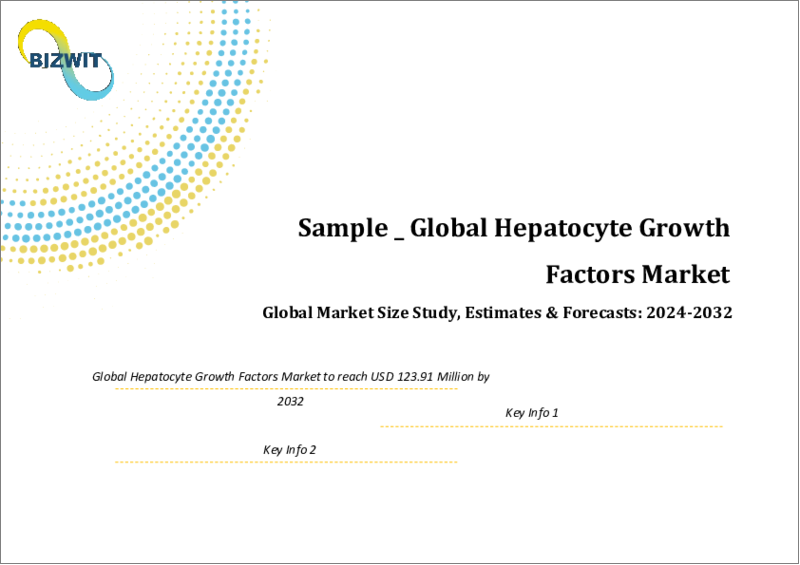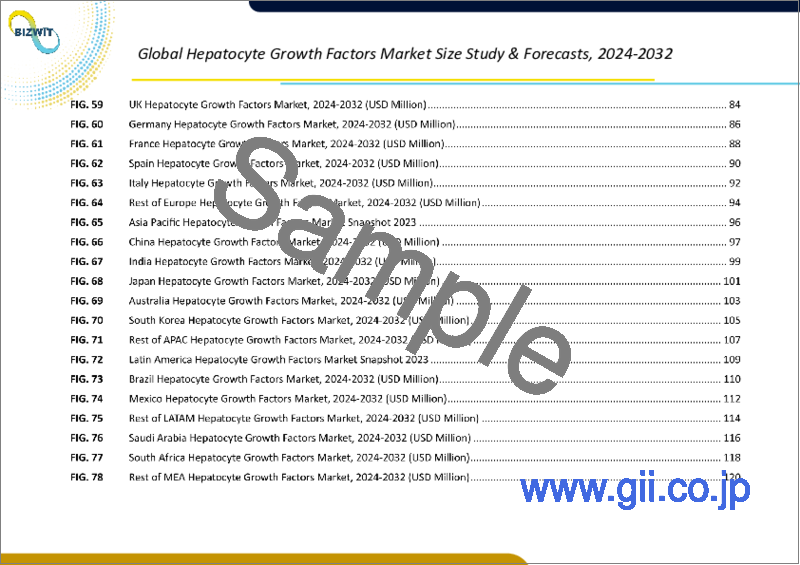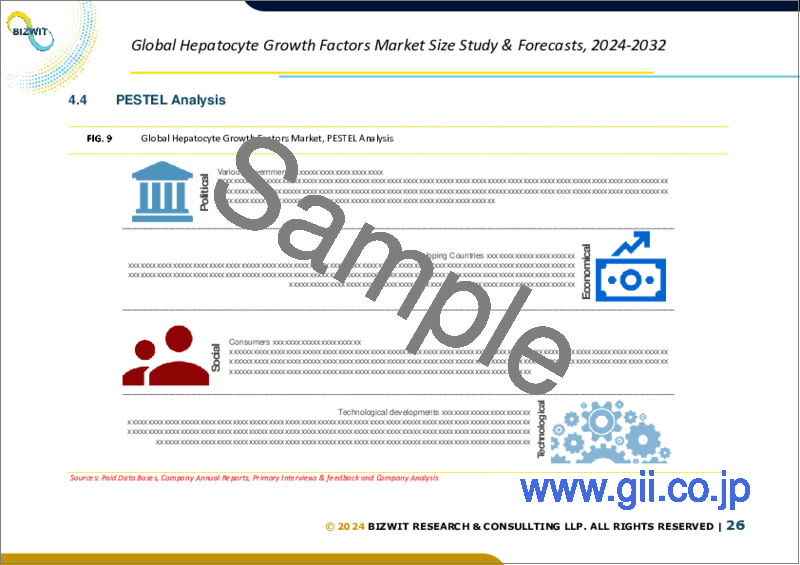|
|
市場調査レポート
商品コード
1538600
肝細胞増殖因子(HGFs)の世界市場:市場規模 - タイプ別、用途別、エンドユーザー別、地域別予測、2022~2032年Global Hepatocyte Growth Factors Market Size Study, by Type (Phase III, Phase II, Phase II, Phase I, Preclinical) by Application by End-User and Regional Forecasts 2022-2032 |
||||||
カスタマイズ可能
|
|||||||
| 肝細胞増殖因子(HGFs)の世界市場:市場規模 - タイプ別、用途別、エンドユーザー別、地域別予測、2022~2032年 |
|
出版日: 2024年08月20日
発行: Bizwit Research & Consulting LLP
ページ情報: 英文 285 Pages
納期: 2~3営業日
|
全表示
- 概要
- 目次
世界の肝細胞増殖因子(HGFs)の市場規模は、2023年に約7,030万米ドルに達し、2024~2032年の予測期間中に6.5%以上の健全な成長率で推移すると予測されています。
肝細胞増殖因子(HGFs)は、肝細胞や、ケラチノサイト、メラノサイト、上皮細胞、内皮細胞など様々な細胞に対する強力な分裂促進因子です。HGFは、c-metがん原遺伝子がコードする受容体のリガンドとして働きます。この増殖因子は、バイオプロセス、細胞培養、再生医療などの多様な応用に不可欠です。これらの因子は細胞活動を刺激・制御し、バイオ医薬品製造に使用される細胞の生存性と最適な成長を保証します。高品質の組換え増殖因子を生産することは高価であり、その利用可能性は限られています。さらに、保存期間が短いため、輸送、保管、製品の生存性に課題があり、これが産業の制約となる可能性があります。しかし、肝臓疾患の急激な増加や、効率的で迅速な創傷治癒のためにHGFの使用を必要とする外科手術の増加により、市場は成長するとみられています。
肝細胞増殖因子市場の企業は、アジア太平洋、ラテンアメリカ、中東・アフリカの未開拓の経済圏に進出し、これらの増殖因子に関する認知度を高め、不適切に管理された手術後の合併症を防ごうとしています。
肝細胞増殖因子(HGF)は、コラーゲンの沈着を含む肝組織の治癒を促進するシグナル伝達経路を通じて肝幹細胞の増殖を促進するため、肝再生に不可欠です。このプロセスは、前駆細胞の増殖と拡大を助長する環境を作り出します。International Journal of Pharmaceutical Chemistry and Analysis誌は、世界の死因の4%を肝疾患としており、肝疾患の適切な治癒の必要性を強調しています。肝細胞増殖因子(HGF)は、様々な細胞において細胞増殖、形態形成、細胞運動性を調節し、創傷治癒の際の新生血管形成と上皮修復を促進します。HGFはホルモン様分子として作用し、専用の細胞表面レセプターと相互作用して組織修復を制御します。HGFはナノグラム単位で存在するにもかかわらず、創傷の修復と治癒に大きな影響を与えます。米国国立衛生研究所によると、年間3億1,000万件以上の大手術が行われており、HGFは術後の創傷治癒に不可欠で、市場規模を拡大しています。
北米は2023年に肝細胞増殖因子市場を独占し、予測期間中もその支配を維持すると予想されます。これは、米国の製薬会社、バイオテクノロジー企業、研究機関による多額の研究開発投資が原因です。アジア太平洋の顕著な市場成長の原動力は、日本の高度なヘルスケアインフラと成熟したバイオ医薬品産業であり、中国の広範な研究開発です。
目次
第1章 世界の肝細胞増殖因子(HGFs)市場のエグゼクティブサマリー
- 世界の肝細胞増殖因子(HGFs)の市場規模・予測(2022~2032年)
- 地域別概要
- セグメント別概要
- タイプ別
- 用途別
- エンドユーザー別
- 主要動向
- 景気後退の影響
- アナリストの結論・提言
第2章 世界の肝細胞増殖因子(HGFs)市場の定義と調査前提条件
- 調査目的
- 市場の定義
- 調査前提条件
- 包含と除外
- 制限事項
- 供給サイドの分析
- 入手可能性
- インフラ
- 規制環境
- 市場競争
- 経済性(消費者の視点)
- 需要サイド分析
- 規制の枠組み
- 技術の進歩
- 環境への配慮
- 消費者の意識と受容
- 調査手法
- 調査対象年
- 通貨換算レート
第3章 世界の肝細胞増殖因子(HGFs)の市場力学
- 市場促進要因
- 肝疾患の発生率の増加
- 外科手術の増加
- 市場の課題
- 高コストと限られた入手しやすさ
- 短い使用期限と保管上の問題
- 市場機会
- 新興市場における認知度の拡大
- バイオテクノロジーと再生医療の進歩
第4章 世界の肝細胞増殖因子(HGFs)市場の産業分析
- ポーターのファイブフォースモデル
- 供給企業の交渉力
- 買い手の交渉力
- 新規参入業者の脅威
- 代替品の脅威
- 競争企業間の敵対関係
- ポーターのファイブフォースモデルへの未来的アプローチ
- ポーターのファイブフォースの影響分析
- PESTEL分析
- 政治
- 経済
- 社会
- 技術
- 環境
- 法律
- 主な投資機会
- 主要成功戦略
- 破壊的動向
- 産業専門家の視点
- アナリストの結論・提言
第5章 世界の肝細胞増殖因子(HGFs)の市場規模・予測:タイプ別、2022~2032年
- セグメントダッシュボード
- 世界の肝細胞増殖因子(HGFs)市場:タイプ別収益動向分析、2022年・2032年
- フェーズIII(進行中)
- フェーズII(承認済み)
- フェーズII(進行中)
- フェーズi
- 前臨床
第6章 世界の肝細胞増殖因子(HGFs)の市場規模・予測:用途別、2022~2032年
- セグメントダッシュボード
- 世界の肝細胞増殖因子(HGFs)市場:用途別収益動向分析、2022年・2032年
- がん領域
- 心血管
- 中枢神経系
- 血液疾患
第7章 世界の肝細胞増殖因子(HGFs)の市場規模・予測:エンドユーザー別、2022~2032年
- セグメントダッシュボード
- 世界の肝細胞増殖因子(HGFs)市場:エンドユーザー別収益動向分析、2022年・2032年
- 製薬・バイオテクノロジー企業
- CMO・CDMO
- 研究センター・学術機関
第8章 世界の肝細胞増殖因子(HGFs)の市場規模・予測:地域別、2022~2032年
- 北米
- 米国
- カナダ
- 欧州
- 英国
- ドイツ
- フランス
- スペイン
- イタリア
- その他の欧州
- アジア太平洋
- 中国
- インド
- 日本
- オーストラリア
- 韓国
- その他のアジア太平洋
- ラテンアメリカ
- ブラジル
- メキシコ
- その他のラテンアメリカ
- 中東・アフリカ
- サウジアラビア
- 南アフリカ
- その他の中東・アフリカ
第9章 競合情報
- 主要企業のSWOT分析
- 主要市場戦略
- 企業プロファイル
- AVEO Pharmaceuticals, Inc.
- Molecular Partners AG
- YooYoung Pharmaceutical Co., Ltd.
- F-star Therapeutics Inc.
- Galaxy Bio Tech
- Kringle Pharma
- Novo Nordisk
- Bristol-Myers Squibb
- AstraZeneca
- Merck & Co., Inc.
- Gilead Sciences, Inc.
- Sanofi
- ViroMed
- AnGes, Inc.
- M3 Biotechnology, Inc.
第10章 調査プロセス
- 調査プロセス
- データマイニング
- 分析
- 市場推定
- 検証
- 出版
- 調査属性
Global Hepatocyte Growth Factors (HGFs) market is valued at approximately USD 70.3 million in 2023 and is anticipated to grow with a healthy growth rate of more than 6.5% over the forecast period 2024-2032. Hepatocyte Growth Factors (HGFs) are potent mitogens for hepatocytes and various other cells including keratinocytes, melanocytes, epithelial, and endothelial cells. HGFs act as ligands for receptors encoded by the c-met proto-oncogene. The growth factors are crucial for diverse applications such as bioprocessing, cell culture, and regenerative medicine. These factors stimulate and regulate cellular activities, ensuring the viability and optimal growth of cells used in biopharmaceutical production. Producing high-quality recombinant growth factors is expensive, limiting their accessibility. Additionally, the short shelf life poses challenges in transportation, storage, and product viability, which may restrain the industry. However, the market is set to grow due to an exponential rise in liver illnesses and the increasing number of surgical operations that necessitate the use of HGFs for efficient and speedy wound healing.
Companies in the hepatocyte growth factors market are expanding their reach to unexplored economies in Asia Pacific, Latin America, and the Middle East & Africa to create awareness about these growth factors and prevent complications from inappropriately managed post-surgical operations.
Hepatocyte Growth Factor (HGF) is essential for liver regeneration as it promotes the growth of liver stem cells through signaling pathways that facilitate hepatic tissue healing, including collagen deposition. This process creates an environment conducive to the growth and expansion of progenitor cells. The International Journal of Pharmaceutical Chemistry and Analysis attributes 4% of global fatalities to liver disease, highlighting the critical need for proper healing of liver illnesses, thereby catalyzing the HGF market. Hepatocyte growth factor (HGF) regulates cell growth, morphogenesis, and cell motility in various cells, promoting neovascularization and epithelial repair during wound healing. HGFs act as hormone-like molecules that interact with exclusive cell surface receptors to control tissue repair. Despite being present in nanograms, they significantly influence wound repair and healing. With over 310 million major surgeries performed annually, according to the National Institutes of Health, HGFs are vital for post-surgical wound healing, expanding the market size.
North America dominated the hepatocyte growth factors market in 2023 and is expected to maintain its dominance during the forecast period, attributed to significant R&D investments by pharmaceutical companies, biotech firms, and research institutions in the U.S. Whereas, the market in Asia Pacific is anticipated to grow at the fastest rate over the forecast period. Asia Pacific's notable market growth is driven by Japan's advanced healthcare infrastructure and matured biopharmaceutical industry, along with extensive R&D in China.
Major market players included in this report are:
- AVEO Pharmaceuticals, Inc.
- Molecular Partners AG
- YooYoung Pharmaceutical Co., Ltd.
- F-star Therapeutics Inc.
- Galaxy Bio Tech
- Kringle Pharma
- Novo Nordisk
- Bristol-Myers Squibb
- AstraZeneca
- Merck & Co., Inc.
- Gilead Sciences, Inc.
- Sanofi SE
- ViroMed
- AnGes, Inc.
- M3 Biotechnology, Inc.
The detailed segments and sub-segment of the market are explained below:
By Type:
- Phase III (Ongoing)
- Phase II (Approved)
- Phase II (Ongoing)
- Phase I
- Preclinical
By Application:
- Oncology
- Cardiovascular
- Central Nervous System
- Hematological Disorders
By End-User:
- Pharmaceutical and Biotechnology Companies
- CMOs & CDMOs
- Research Centers & Academic Institutes
By Region:
- North America
- U.S.
- Canada
- Europe
- UK
- Germany
- France
- Spain
- Italy
- ROE
- Asia Pacific
- China
- India
- Japan
- Australia
- South Korea
- RoAPAC
- Latin America
- Brazil
- Mexico
- RoLA
- Middle East & Africa
- Saudi Arabia
- South Africa
- RoMEA
Years considered for the study are as follows:
- Historical year - 2022
- Base year - 2023
- Forecast period - 2024 to 2032
Key Takeaways:
- Market Estimates & Forecast for 10 years from 2022 to 2032.
- Annualized revenues and regional level analysis for each market segment.
- Detailed analysis of geographical landscape with Country level analysis of major regions.
- Competitive landscape with information on major players in the market.
- Analysis of key business strategies and recommendations on future market approach.
- Analysis of competitive structure of the market.
- Demand side and supply side analysis of the market.
Table of Contents
Chapter 1. Global Hepatocyte Growth Factors (HGFs) Market Executive Summary
- 1.1. Global Hepatocyte Growth Factors (HGFs) Market Size & Forecast (2022- 2032)
- 1.2. Regional Summary
- 1.3. Segmental Summary
- 1.3.1. By Type
- 1.3.2. By Application
- 1.3.3. By End-User
- 1.4. Key Trends
- 1.5. Recession Impact
- 1.6. Analyst Recommendation & Conclusion
Chapter 2. Global Hepatocyte Growth Factors (HGFs) Market Definition and Research Assumptions
- 2.1. Research Objective
- 2.2. Market Definition
- 2.3. Research Assumptions
- 2.3.1. Inclusion & Exclusion
- 2.3.2. Limitations
- 2.3.3. Supply Side Analysis
- 2.3.3.1. Availability
- 2.3.3.2. Infrastructure
- 2.3.3.3. Regulatory Environment
- 2.3.3.4. Market Competition
- 2.3.3.5. Economic Viability (Consumer's Perspective)
- 2.3.4. Demand Side Analysis
- 2.3.4.1. Regulatory frameworks
- 2.3.4.2. Technological Advancements
- 2.3.4.3. Environmental Considerations
- 2.3.4.4. Consumer Awareness & Acceptance
- 2.4. Estimation Methodology
- 2.5. Years Considered for the Study
- 2.6. Currency Conversion Rates
Chapter 3. Global Hepatocyte Growth Factors (HGFs) Market Dynamics
- 3.1. Market Drivers
- 3.1.1. Rise in Incidence of Liver Illnesses
- 3.1.2. Increase in Surgical Operations
- 3.2. Market Challenges
- 3.2.1. High Cost and Limited Accessibility
- 3.2.2. Short Shelf Life and Storage Issues
- 3.3. Market Opportunities
- 3.3.1. Expanding Awareness in Emerging Markets
- 3.3.2. Advances in Biotechnology and Regenerative Medicine
Chapter 4. Global Hepatocyte Growth Factors (HGFs) Market Industry Analysis
- 4.1. Porter's 5 Force Model
- 4.1.1. Bargaining Power of Suppliers
- 4.1.2. Bargaining Power of Buyers
- 4.1.3. Threat of New Entrants
- 4.1.4. Threat of Substitutes
- 4.1.5. Competitive Rivalry
- 4.1.6. Futuristic Approach to Porter's 5 Force Model
- 4.1.7. Porter's 5 Force Impact Analysis
- 4.2. PESTEL Analysis
- 4.2.1. Political
- 4.2.2. Economical
- 4.2.3. Social
- 4.2.4. Technological
- 4.2.5. Environmental
- 4.2.6. Legal
- 4.3. Top Investment Opportunity
- 4.4. Top Winning Strategies
- 4.5. Disruptive Trends
- 4.6. Industry Expert Perspective
- 4.7. Analyst Recommendation & Conclusion
Chapter 5. Global Hepatocyte Growth Factors (HGFs) Market Size & Forecasts by Type 2022-2032
- 5.1. Segment Dashboard
- 5.2. Global Hepatocyte Growth Factors (HGFs) Market: Type Revenue Trend Analysis, 2022 & 2032 (USD Million)
- 5.2.1. Phase III (Ongoing)
- 5.2.2. Phase II (Approved)
- 5.2.3. Phase II (Ongoing)
- 5.2.4. Phase I
- 5.2.5. Preclinical
Chapter 6. Global Hepatocyte Growth Factors (HGFs) Market Size & Forecasts by Application 2022-2032
- 6.1. Segment Dashboard
- 6.2. Global Hepatocyte Growth Factors (HGFs) Market: Application Revenue Trend Analysis, 2022 & 2032 (USD Million)
- 6.2.1. Oncology
- 6.2.2. Cardiovascular
- 6.2.3. Central Nervous System
- 6.2.4. Hematological Disorders
Chapter 7. Global Hepatocyte Growth Factors (HGFs) Market Size & Forecasts by End-User 2022-2032
- 7.1. Segment Dashboard
- 7.2. Global Hepatocyte Growth Factors (HGFs) Market: End-User Revenue Trend Analysis, 2022 & 2032 (USD Million)
- 7.2.1. Pharmaceutical and Biotechnology Companies
- 7.2.2. CMOs & CDMOs
- 7.2.3. Research Centers & Academic Institutes
Chapter 8. Global Hepatocyte Growth Factors (HGFs) Market Size & Forecasts by Region 2022-2032
- 8.1. North America Hepatocyte Growth Factors (HGFs) Market
- 8.1.1. U.S. Hepatocyte Growth Factors (HGFs) Market
- 8.1.1.1. Type breakdown size & forecasts, 2022-2032
- 8.1.1.2. Application breakdown size & forecasts, 2022-2032
- 8.1.1.3. End-User breakdown size & forecasts, 2022-2032
- 8.1.2. Canada Hepatocyte Growth Factors (HGFs) Market
- 8.1.1. U.S. Hepatocyte Growth Factors (HGFs) Market
- 8.2. Europe Hepatocyte Growth Factors (HGFs) Market
- 8.2.1. U.K. Hepatocyte Growth Factors (HGFs) Market
- 8.2.2. Germany Hepatocyte Growth Factors (HGFs) Market
- 8.2.3. France Hepatocyte Growth Factors (HGFs) Market
- 8.2.4. Spain Hepatocyte Growth Factors (HGFs) Market
- 8.2.5. Italy Hepatocyte Growth Factors (HGFs) Market
- 8.2.6. Rest of Europe Hepatocyte Growth Factors (HGFs) Market
- 8.3. Asia-Pacific Hepatocyte Growth Factors (HGFs) Market
- 8.3.1. China Hepatocyte Growth Factors (HGFs) Market
- 8.3.2. India Hepatocyte Growth Factors (HGFs) Market
- 8.3.3. Japan Hepatocyte Growth Factors (HGFs) Market
- 8.3.4. Australia Hepatocyte Growth Factors (HGFs) Market
- 8.3.5. South Korea Hepatocyte Growth Factors (HGFs) Market
- 8.3.6. Rest of Asia Pacific Hepatocyte Growth Factors (HGFs) Market
- 8.4. Latin America Hepatocyte Growth Factors (HGFs) Market
- 8.4.1. Brazil Hepatocyte Growth Factors (HGFs) Market
- 8.4.2. Mexico Hepatocyte Growth Factors (HGFs) Market
- 8.4.3. Rest of Latin America Hepatocyte Growth Factors (HGFs) Market
- 8.5. Middle East & Africa Hepatocyte Growth Factors (HGFs) Market
- 8.5.1. Saudi Arabia Hepatocyte Growth Factors (HGFs) Market
- 8.5.2. South Africa Hepatocyte Growth Factors (HGFs) Market
- 8.5.3. Rest of Middle East & Africa Hepatocyte Growth Factors (HGFs) Market
Chapter 9. Competitive Intelligence
- 9.1. Key Company SWOT Analysis
- 9.2. Top Market Strategies
- 9.3. Company Profiles
- 9.3.1. AVEO Pharmaceuticals, Inc.
- 9.3.1.1. Key Information
- 9.3.1.2. Overview
- 9.3.1.3. Financial (Subject to Data Availability)
- 9.3.1.4. Product Summary
- 9.3.1.5. Market Strategies
- 9.3.2. Molecular Partners AG
- 9.3.3. YooYoung Pharmaceutical Co., Ltd.
- 9.3.4. F-star Therapeutics Inc.
- 9.3.5. Galaxy Bio Tech
- 9.3.6. Kringle Pharma
- 9.3.7. Novo Nordisk
- 9.3.8. Bristol-Myers Squibb
- 9.3.9. AstraZeneca
- 9.3.10. Merck & Co., Inc.
- 9.3.11. Gilead Sciences, Inc.
- 9.3.12. Sanofi
- 9.3.13. ViroMed
- 9.3.14. AnGes, Inc.
- 9.3.15. M3 Biotechnology, Inc.
- 9.3.1. AVEO Pharmaceuticals, Inc.
Chapter 10. Research Process
- 10.1. Research Process
- 10.1.1. Data Mining
- 10.1.2. Analysis
- 10.1.3. Market Estimation
- 10.1.4. Validation
- 10.1.5. Publishing
- 10.2. Research Attributes






